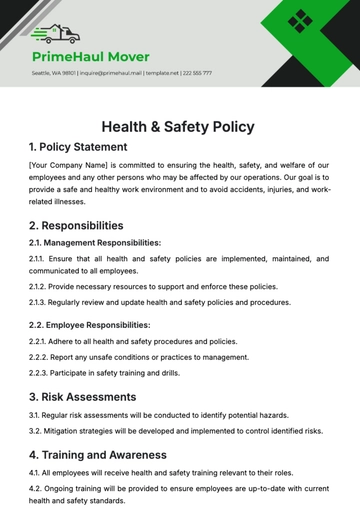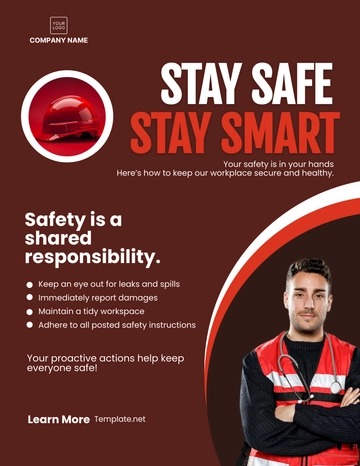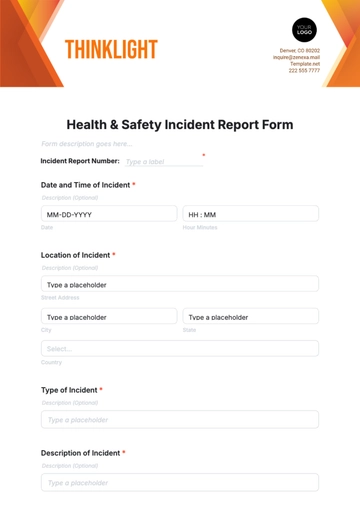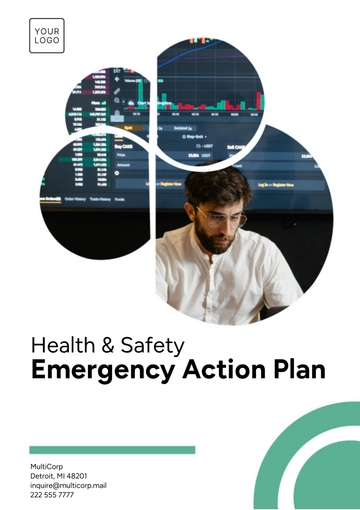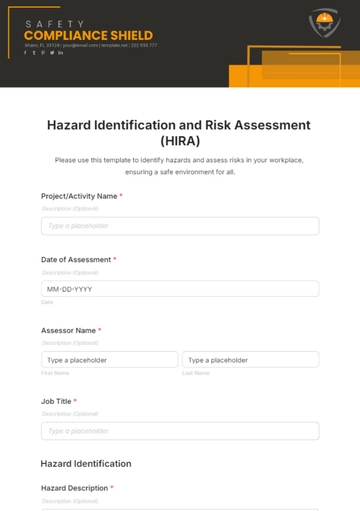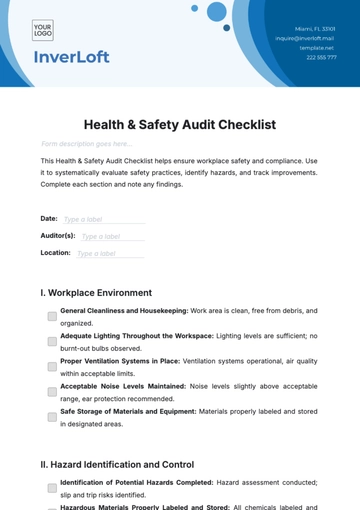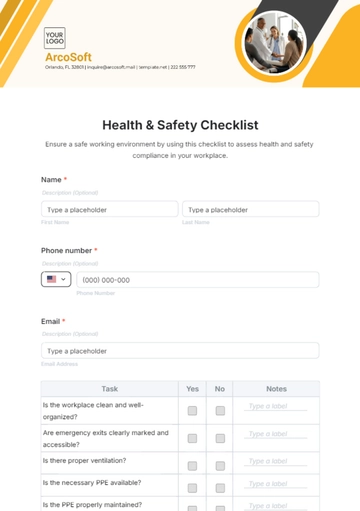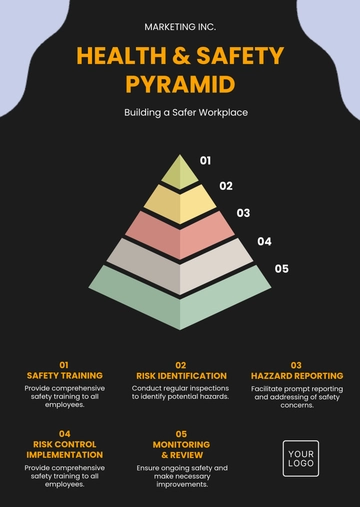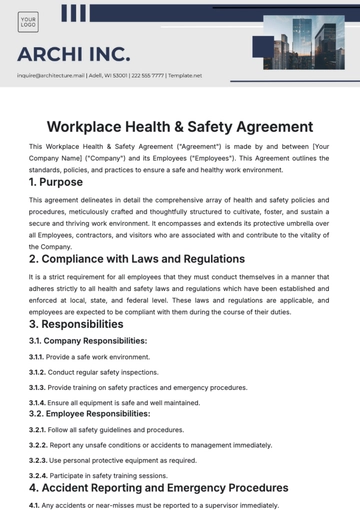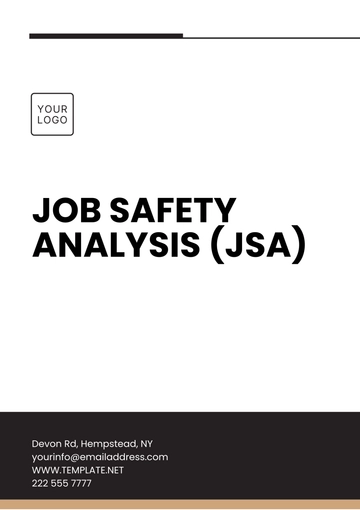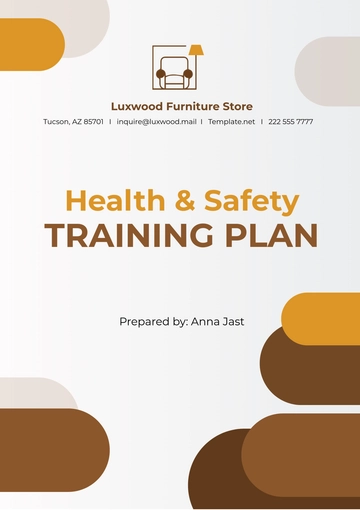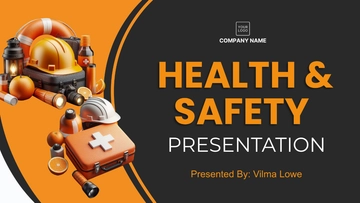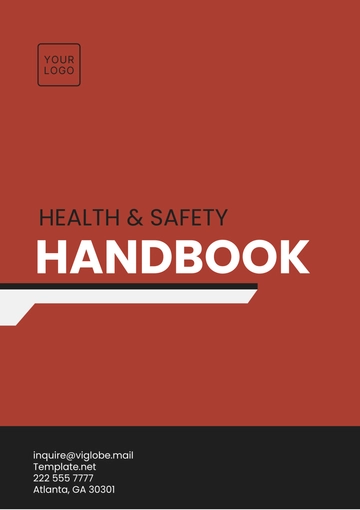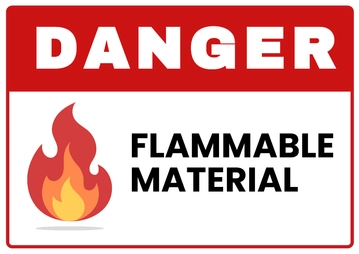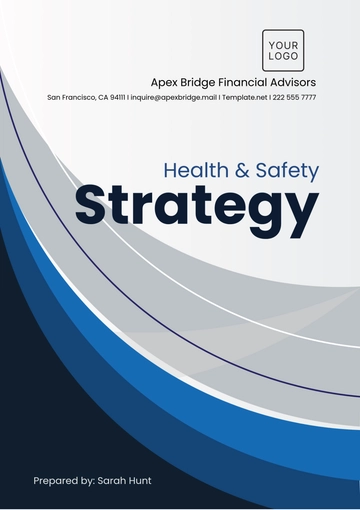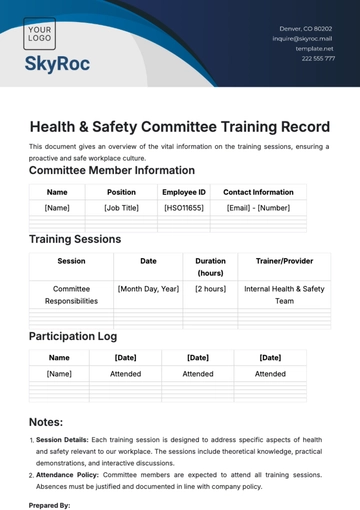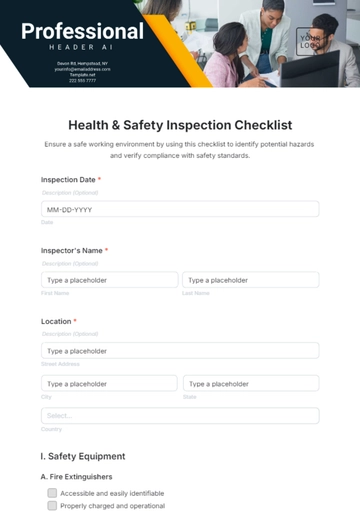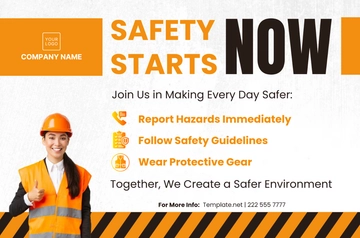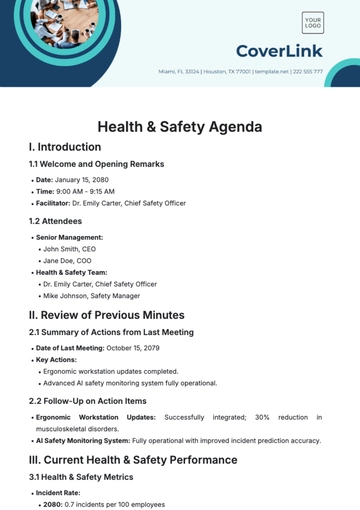Free Health & Safety Committee Leadership Guide
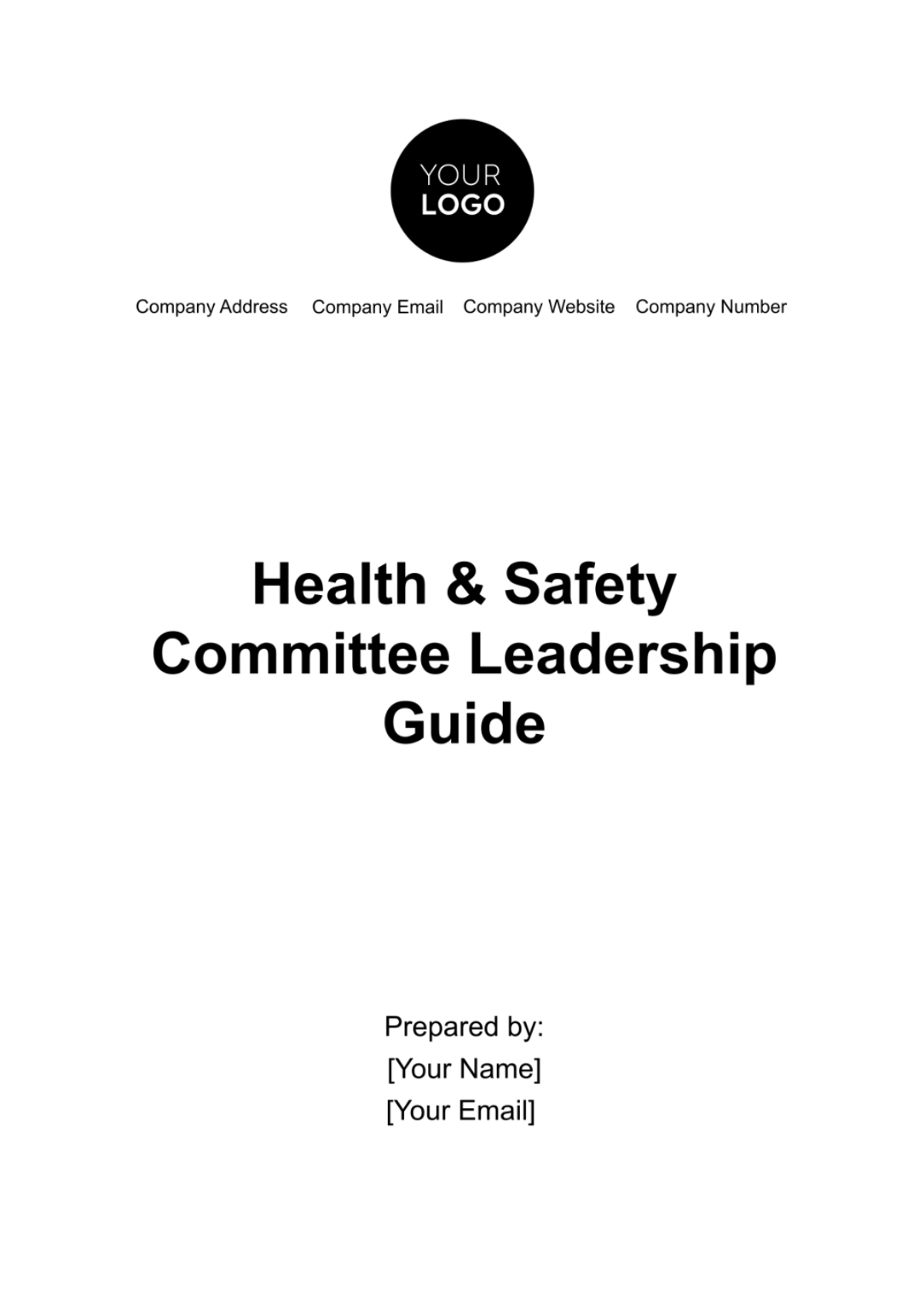
Introduction
A. Purpose
This resource is created to empower leaders within our company to navigate the dynamic landscape of workplace health and safety. This guide is tailored to individuals in leadership roles within the committee, recognizing the pivotal role they play in driving initiatives, fostering a safety-conscious culture, and aligning safety goals with broader company objectives. By providing clear insights, tools, and strategies, this guide aims to enhance the effectiveness of our leaders, ensuring they are well-equipped to steer the Health and Safety Committee toward continuous improvement and excellence.
B. Objectives
The objectives of this leadership guide are:
1. Equip Leaders with Essential Knowledge
1.1 Provide leaders with a comprehensive understanding of their roles and responsibilities within the Health and Safety Committee.
1.2 Ensure leaders are well-versed in key health and safety protocols, legal compliance, and the broader company context.
2. Enhance Leadership Skills
2.1 Foster the development of leadership skills necessary for effective communication, decision-making, and conflict resolution within the committee.
2.2 Provide insights into strategic planning, resource management, and the ability to drive continuous improvement initiatives.
3. Align Safety Goals with company Objectives
3.1 Guide leaders in aligning health and safety initiatives with broader company goals and objectives.
3.2 Encourage leaders to play a strategic role in ensuring that safety measures contribute to the overall success and sustainability of the company.
II. Leadership Roles and Responsibilities
As leaders within the Health & Safety Committee, your roles and responsibilities extend beyond routine functions. The following table provides a detailed breakdown of what is expected from leaders, emphasizing the critical aspects that contribute to the committee's success.
Name | Leadership Role | Responsibilities |
[Wade Taylor] | [Committee Chair] | [Facilitate committee meetings with efficiency and effectiveness.] |
The table above delineates the essential functions expected from leaders within the Health and Safety Committee. This comprehensive breakdown is a cornerstone resource, elucidating the unique responsibilities associated with leadership positions. The roles identified are instrumental in steering the committee's initiatives. Responsibilities include facilitation of meetings, agenda setting, representation in interactions with senior management, providing support, ensuring transparent communication, and safeguarding legal compliance. Each role plays a distinctive and strategic part in advancing the committee's objectives, underscoring the diverse contributions that leaders make to foster workplace health and safety.
III. Communication Strategies
A. Regular Updates
Ensure that regular updates on safety-related activities, changes in procedures, and industry trends are consistently communicated.
Establish a structured schedule for disseminating updates to keep all committee members well-informed and aligned with ongoing safety initiatives.
B. Open Forum Discussions
Encourage open forum discussions to provide a platform for committee members to freely share insights, experiences, and concerns.
Fostering an environment where diverse perspectives are welcomed enhances collaboration and enriches the decision-making process.
C. Feedback Channels
Establish formal and informal feedback channels to facilitate two-way communication.
Actively encourage committee members to voice their opinions, suggestions, and concerns.
D. Visual Communication Aids
Utilize visual aids such as posters, infographics, and presentations to enhance the visibility of key safety messages. Visual communication aids are effective tools for reinforcing important safety information, especially in environments where language barriers or varied literacy levels may exist among committee members.
E. Emergency Protocols
Develop clear and concise emergency communication protocols to ensure swift dissemination of information during crises. Outline communication chains, establish designated emergency communication channels, and conduct regular drills to familiarize committee members with communication procedures in urgent situations.
IV. Strategic Planning
A. Align with company Goals
Ensure health and safety initiatives align seamlessly with broader company goals.
Actively engage with company leaders to understand business objectives, identify intersections with safety initiatives.
Ensure the committee's efforts contribute meaningfully to overall success.
B. Develop Long-Term Strategies
Collaborate with committee members to develop long-term strategies that transcend day-to-day operations.
Outline the committee's vision, goals, and a roadmap for sustained impact.
Guide the strategic planning process, leveraging the collective expertise of the committee.
C. Assess Effectiveness
Regularly assess the effectiveness of health and safety programs through key performance indicators (KPIs) and data-driven metrics.
Establish mechanisms for ongoing evaluation, conduct regular reviews, and use insights gained to fine-tune strategies, ensuring the committee's initiatives consistently meet predefined objectives.
V. Decision-Making Processes
A. Consensus-Building
Facilitate open dialogue and collaboration to reach agreements acceptable to all committee members.
Encourage a culture of consensus-building that ensures decisions resonate with the entire committee, fostering a sense of collective ownership and commitment.
B. Data-Driven Decision-Making
Leaders must champion a data-driven approach, ensuring that decisions are grounded in empirical evidence to enhance the effectiveness and relevance of safety initiatives. Rely on data, incident reports, and key performance indicators to inform decisions and set priorities.
C. Managing Differing Perspectives
Develop strategies for managing and incorporating diverse opinions and perspectives within the committee. Acknowledge the richness that diverse perspectives bring to decision-making, fostering an inclusive environment where varying viewpoints are valued and considered.
VI. Conflict Resolution
A. Open Communication
Foster an environment where committee members feel comfortable expressing concerns and conflicts.
Promote transparent communication channels that allow conflicts to be addressed openly, preventing potential escalation and maintaining a healthy committee dynamic.
B. Mediation
Utilize mediation techniques to address conflicts effectively. When conflicts arise, provide a structured mediation process that allows involved parties to express their concerns, facilitates understanding, and works towards mutually agreeable resolutions.
C. Proactive Conflict Prevention
Implement proactive measures to prevent conflicts before they escalate. Encourage open communication, set clear expectations, and establish protocols for addressing potential conflicts in their early stages, creating a harmonious committee environment.
VII. Training and Development
A. Needs Assessment
Understanding the specific training needs allows leaders to tailor programs that address deficiencies and enhance the overall competency of the Health & Safety Committee. Conduct a comprehensive needs assessment to identify gaps in knowledge and skills among committee members.
B. Training Program Design
Design training programs that are engaging, relevant, and aligned with the committee's goals.
Utilize a variety of training methods, including workshops, seminars, and online resources, to accommodate diverse learning styles and ensure the effective transfer of knowledge.
C. Continuous Learning Culture
Promote a culture of continuous learning within the committee.
Encourage members to seek additional training opportunities, stay updated on industry best practices, and share newfound knowledge with the broader committee, fostering a dynamic learning environment.
VIII. Recognition and Incentives
A. Acknowledgment Programs
Implement acknowledgment programs to recognize the contributions of committee members.
Regularly acknowledge individual and collective efforts, fostering a positive atmosphere that reinforces the value of each member's dedication to workplace health and safety.
B. Incentive Structures
Explore incentive structures that motivate and reward exemplary performance within the committee.
Consider tangible and intangible incentives that align with the company's culture and values, recognizing and appreciating the commitment of members.
IX. Evaluation and Improvement
A. Performance Metrics
Establish clear performance metrics to evaluate the effectiveness of the Health & Safety Committee. Define key indicators, such as incident reduction rates, participation levels, and the impact of implemented safety measures, to gauge the committee's overall performance.
B. Regular Assessments
Conduct regular assessments to identify areas of improvement.
Implement a structured evaluation process that includes feedback from committee members, incident analyses, and a review of the committee's alignment with company safety goals.
C. Continuous Improvement Plans
Leaders should collaboratively formulate actionable strategies to address identified weaknesses, enhance committee processes, and ensure ongoing effectiveness in promoting workplace health and safety. Develop continuous improvement plans based on assessment findings.
X. Sustainability and Succession Planning
A. Long-Term Sustainability
Leaders should assess the committee's structure, processes, and initiatives to identify potential challenges and proactively address factors that could impact its sustainability. Develop strategies for ensuring the long-term sustainability of the Health & Safety Committee.
B. Succession Planning
Implement a robust succession planning framework to prepare for leadership transitions.
Identify potential successors, provide training and mentorship opportunities, and create a seamless transition plan to ensure continuity in the committee's leadership and effectiveness.
C. Knowledge Transfer
Facilitate knowledge transfer mechanisms to preserve institutional knowledge within the committee.
Establish documentation protocols, mentorship programs, and knowledge-sharing sessions to ensure that valuable insights and experiences are passed on to new committee members.
XI. Collaboration and Networking
A. External Partnerships
Establishing external partnerships enhances the committee's access to valuable resources, industry insights, and best practices, enriching its ability to address emerging safety challenges. Foster collaborations with external companies, regulatory bodies, and industry experts.
B. Knowledge Sharing Platforms
Leaders should encourage committee members to actively engage in external forums, expanding their network, staying abreast of industry developments, and bringing valuable insights back to the committee.
Participate in knowledge-sharing platforms, conferences, and industry events.
C. Internal Cross-Functional Collaboration
Promote cross-functional collaboration within the company. Encourage the Health & Safety Committee to collaborate with other departments, sharing insights and coordinating efforts to address safety challenges that may cut across different areas of the company.
XII. Technology Integration
A. Utilizing Safety Technologies
Leaders should stay informed about emerging safety tools, such as incident reporting systems, wearables, and data analytics, and assess their applicability to improve safety measures and decision-making. Explore and integrate relevant safety technologies to enhance committee effectiveness.
B. Training on Technology Use
Provide training on the use of safety technologies to committee members.
Ensure that members are proficient in leveraging technological tools to streamline processes, collect data, and enhance the overall efficiency of safety-related initiatives.
C. Data Security Measures
Leaders must prioritize the confidentiality and integrity of safety-related data, ensuring that technology integration aligns with company data security policies and industry best practices. Implement robust data security measures when utilizing technology.
XIII. Reporting and Documentation
A. Incident Reporting Protocols
Clear Reporting Channels
Establish and communicate clear reporting channels for incidents within the committee. Ensure that all members are aware of the designated channels, whether it be through an incident reporting platform, designated contact person, or an established reporting form.
Standardized Incident Forms
Create standardized incident reporting forms that capture essential information. These forms should include details such as the nature of the incident, date and time, individuals involved, witnesses, and a brief description. Standardization ensures consistency in reporting and facilitates thorough analysis.
Timely Reporting Expectations
Set expectations for timely incident reporting. Emphasize the importance of reporting incidents promptly, regardless of severity, to facilitate swift responses and prevent potential escalation.
B. Documentation Best Practices
Detailed Incident Documentation
1.1 Train committee members on the importance of detailed incident documentation.
1.2 Guide the committee in recording all pertinent details, including the sequence of events, actions taken, and any follow-up measures. Thorough documentation aids in comprehensive analysis and future prevention efforts.
Consistent Recordkeeping
Establish consistent recordkeeping practices. Emphasize the need for organized and accessible records, whether in digital or physical formats. Consistency ensures that documentation is readily available for analysis, reporting, and compliance verification.
Documentation Review Protocols
Implement regular documentation review protocols. Leaders should guide committee members in conducting periodic reviews of incident documentation to identify trends, recurring issues, and areas for improvement. Regular reviews contribute to continuous learning and improvement.
- 100% Customizable, free editor
- Access 1 Million+ Templates, photo’s & graphics
- Download or share as a template
- Click and replace photos, graphics, text, backgrounds
- Resize, crop, AI write & more
- Access advanced editor
Unlock the potential of your Health & Safety Committee with Template.net's Leadership Guide Template. This editable and customizable resource, coupled with our intuitive Ai Editor Tool, empowers leaders to navigate safety protocols seamlessly. Ensure workplace safety with confidence and precision using Template.net's innovative solutions for effective committee leadership.

